PharmaVOICE tapped the nearly 100 industry executives identified by their companies as HBA Rising Stars and Luminaries to identify the biggest trends they believe will impact the industry in the next few years. Top on their list are digital and technology solutions, disruption, and innovation. They also tackle the topics of patient-centricity, health and wellness, and pricing. For information about the Healthcare Businesswomen’s Association (HBA) and its awards, visit hbanet.org. And to read more from these industry leaders, visit pharmavoice.com/digital/HBA.
Aging Populations
Heidi Casaletto — Luminary
VP, Business Fields-Transfusion Medicine, Business Fields Marketing, Ortho Clinical Diagnostics
Because of all of the amazing healthcare advances that have been developed, the number of people age 65 or older is anticipated to triple by 2050. Essentially people are living longer, more active lives than ever before. Much of this growth is expected to happen in developing countries. The increase in life expectancy brought on by ongoing improvements in standard of care is placing more stress on healthcare systems globally.
Maureen Silverman — Rising Star
Director, Clinical Operations, Shionogi
Overall advances in science and technology have significantly improved early diagnostics and treatment of serious and chronic diseases such as cancer and diabetes. Because of these improvements, overall life expectancy has increased, which leads to an increase in the aging population, people who will need to continue to receive prolonged treatment for their chronic illnesses. Consequently, I foresee a further increase in home healthcare services to meet the needs of the aging population.
Artificial Intelligence
Vanessa Breschard — Rising Star
Executive Creative Director, Health & Wellness Partners
What seemed like science fiction not that long ago is coming to life — actively. Artificial voices such as Alexa can now think and respond based on your answers with a human tone. As cited by USF Health, Amazon’s voice-enabled device was the centerpiece of The Alexa Diabetes Challenge, in which developers were pitted against one another to create ways in which Alexa could be used to help Type 2 diabetes patients manage their condition. The winner, called Sugarpod, involved the use of a voice-powered scale and foot scanner that examines the feet of the patient, where signs of diabetes often surface. With diagnostic technology on the rise, taking humans out of a diagnosis is opening a dangerous cyber world that might be too easily embraced as fact before its time.
Margaret Faul — Rising Star
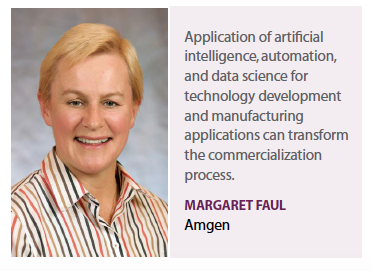 Executive Director, Process Development, Amgen
Executive Director, Process Development, Amgen
Application of AI, automation, and data science for technology development and manufacturing applications can transform the commercialization process. The increase in the volume, variety, and velocity of data gained during development of molecules across our portfolio has created the opportunity to gain significant insights. These data-driven insights will enable us to rapidly assimilate prior knowledge, complement lab experimentation with in-silico modeling, and reduce cycle times for development activities such as regulatory filings.
Shelley Rahe — Rising Star
Senior VP, Client Service Director, CDM New York
AI for sure is a No. 1 trend. Harnessing the power of supercomputers and machine learning will transform everything from how we develop medicines more effectively and quickly to how we better support patients’ experiences and engagements with their health. What I’m most excited about is its ability to speed up rare disease diagnosis and hopefully mitigate life-threatening risks using predictive analysis. Ultimately, it will empower doctors to make swift decisions on the results can impact quality of life in a meaningful way, save lives, and avoid unnecessary costs. But despite the industry beginning to partner with AI start-ups 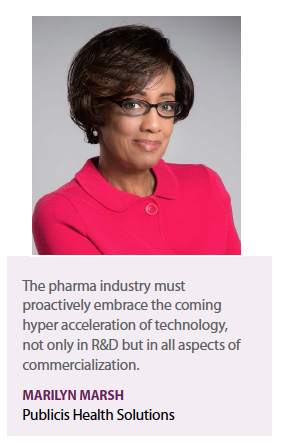 everywhere you look, it feels like it’s a bit of a sleeping giant for healthcare, likely due to the very real challenges that come with combining human beings, machines, and new processes together. I’m optimistic that we’ll be able to solve these issues with our partners soon to start bringing the real, tangible benefits of artificial intelligence to healthcare.
everywhere you look, it feels like it’s a bit of a sleeping giant for healthcare, likely due to the very real challenges that come with combining human beings, machines, and new processes together. I’m optimistic that we’ll be able to solve these issues with our partners soon to start bringing the real, tangible benefits of artificial intelligence to healthcare.
Erin Rathbone — Rising Star
Senior Manager, Client Services, Inovalon
Leveraging artificial intelligence and machine learning to interpret all forms of unstructured and structured data — from wearables, medical records, etc. — to identify preventative care solutions that are delivered to patients directly and frequently, I believe will have a significant impact. AI offers efficiency, accuracy, and accessibility in our current on-demand culture, while also promoting cost-savings in a landscape in which costs are continually rising.
Chaka Serrant — Rising Star
Senior Business Analyst, Knowledgent
A major trend that is and will continue to impact not only the life-sciences industry, but every industry today is artificial intelligence. The capability of machines to perform systematic analysis on medical data to predict disease or simply advise doctors and nurses on patient care can significantly impact care in the future and hopefully result in quicker recovery periods and, perhaps, a decrease in patient deaths.
Collaboration
Jessica Coffey — Rising Star
Director, National Markets Account Management, Cardinal Health
We will continue to see the healthcare system identify opportunities to evolve and become more patient-centric, all while incorporating the right healthcare professionals.
Rachel Frizberg — Luminary
Commercial Director Region Europe, Roche
There will be more experimental partnerships between health systems and pharma. The healthcare sustainability agenda will build significant momentum and positively disrupt the relationships between innovative pharmaceutical companies and health systems. It’s clear that conventional approaches to healthcare will not work in the future. The unrelenting challenges of rising costs and growing demand are creating an environment where public and private organizations will be more willing to work together and experiment with new healthcare models. Pharmaceutical companies that can offer outcomes-based value propositions that span the healthcare continuum — from prevention, diagnostics, and innovative treatments through to service optimization — will begin to stand out as invested healthcare partners who can deliver value to a wider society rather than just supply medicines.
Coleen Glessner — Luminary
Senior VP and Chief Quality Officer, Alexion Pharmaceuticals
Unprecedented partnerships with unusual suspects is trending. Outside influencers, such as online retailers and philanthropic organizations, are emerging in the field, which is necessitating reinvention and simplification of traditional methods and models.
Priti Hegde — Rising Star
Director, Genentech
In the past, large pharma had a go-it-alone strategy to drug development. Over the last few years, we have seen an unprecedented openness among drug developers, both small and large, in co-development of drugs, particularly combinations in oncology. Today, there are more than 1,500 clinical trials in just the field of cancer immunotherapy with 900 drug combinations being investigated. Companies are eager to collaborate with innovative partnership terms that can range from cost sharing of trials, revenue sharing models, and co-marketing models. An upside of this trend will be great for patients as it allows transformative therapies to be available to patients sooner.However, it remains to be seen how pricing of products would impact uptake of 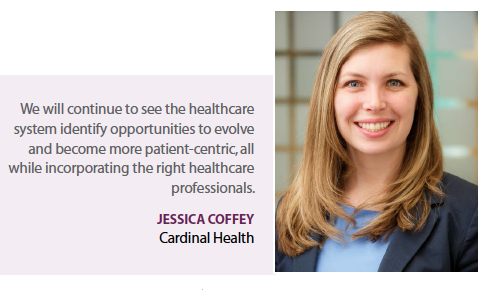 these drugs and overall burden on healthcare. In principle, if drugs being combined belong to the same drug manufacturer, there could be greater flexibility in pricing of products. With this new trend, we may see innovative payment models such as value-based reimbursement to make patient care more cost-effective.
these drugs and overall burden on healthcare. In principle, if drugs being combined belong to the same drug manufacturer, there could be greater flexibility in pricing of products. With this new trend, we may see innovative payment models such as value-based reimbursement to make patient care more cost-effective.
Devayani Pophali — Rising Star
Senior Director, Field Operations, Mallinckrodt Pharmaceuticals
Collaborations are occurring across industries and new models are emerging from tech and retail industries. This shows that the future of M&A might not be linear within the healthcare industry. We need to be able to think outside of the box. And one way to achieve this is by having people with diverse education, life, professions, and experiences bringing their voice to the table.
Culture and Transformational Leadership
Dana Dodzik — Rising Star
Senior Director, Corporate Communications, Lundbeck
While the healthcare industry has long been held in high esteem, today the sector is working to restore its cache and break the perception of it as a complicated, flawed, and costly system that’s not providing people with the best care or value. Given that the industry is in this transformative period, attracting and retaining the highest caliber of next-generation scientists and future healthcare leaders is critical to ensure healthcare companies continue to thrive and innovate to help people live better and healthier lives. To do this, companies need to harness the heart and the power of their organizations and unite their teams behind the organization’s purpose. Creating and sustaining this type of aligned and purpose-driven culture requires a company to carefully define what it stands for and why it exists, and then live out these principles daily. When individuals can identify with a company’s purpose, they build an emotional attachment to the company, are proud of their relationship with the company, and are willing to go above and beyond to make the organization a success. Constant and fervent articulation of the purpose, inside and outside of the organization, helps connect people to the purpose, creates an atmosphere of accountability, and dramatically improves results and value for all stakeholders. Earlier in my career, one of my mentors told me that working in the healthcare industry is a privilege and one to be taken seriously. By creating passionate industry 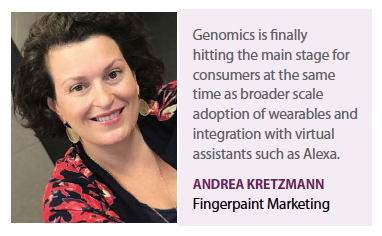 ambassadors aligned to make a positive impact on people’s health, we can ensure this privilege and responsibility is upheld. The need has never been greater.
ambassadors aligned to make a positive impact on people’s health, we can ensure this privilege and responsibility is upheld. The need has never been greater.
Joy Fitzgerald — Rising Star
Chief Diversity Officer, Eli Lilly and Company
A diverse, inclusive workforce is essential for excellence and innovation in healthcare. To be successful, we must understand all of our customers, in their many dimensions of difference. Companies will need to rethink how they recruit, develop, and retain diverse talent to drive greater value for customers.
Mary James — Rising Star
Senior Director, Research & Analytics, W2O Group
Research shows that employees who are healthy and happy are more productive. At W2O, all employees receive a wellness stipend each year. It can go toward gym memberships, acupuncture, new sneakers — you name it. As employees work harder, faster, and longer, I think we’ll see an uptick in companies facilitating, even mandating wellness programs, for employees, in an effort to reduce the cost of insurance, create a healthier environment, and prevent chronic disease. I expect to see innovative approaches to keeping employees healthier and happier, longer.
Lauren Lewis — Luminary
Executive VP, Managing Director, McCann Torre Lazur
Rewind 20 years and the healthcare industry was booming — significant budgets and blockbuster products dominated. The future of pharma seemed untouchable, but that was an unsustainable trend both for molecule and money. Gone are the days of being only attracted to what was the glamour of our industry; now the beauty is found in getting back to basics. As such, the job of client services has seen greater exposure. We see clients seeking agency partners who foundationally have a genuine interest in the job of marketeering. We see the industry attracting individuals who chose healthcare because they truly love the job and want to make a difference.
Rosemary Rebuli — Luminary
Global Head of Trial Management, Novartis Pharmaceuticals
A diverse, open, humanistic leadership will begin to be a predictor for success for companies in our healthcare industry. We live in an exciting time. We have more opportunities for partnership to harness the power of data and automation, and to work with patients and health authorities than ever before. We will need leaders who are able to unite an organization around one purpose, actively seek diversity of thought, experience, and background internally and externally and then be able to recognize, optimize, and prioritize the game-changing idea when they encounter it.
Jamie Spaeth — Rising Star
Head of HR, US Commercial, Shire
With an increasingly flexible work environment, for example work from home, work/live in different geographies, companies need to think how to redefine organizational culture.
Onelia Ann Vera — Luminary
Head Counsel, Hematology, Shire
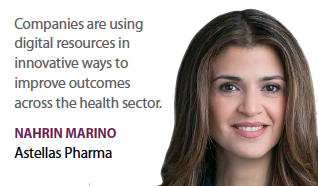 Law departments are expected to do more with less. Lawyers cover broader business areas — multiple products, franchises, etc. — and must be willing to service a very diverse client base. In-house lawyers are valued as much for their business acumen and strategic thinking, as they are for their legal technical expertise.
Law departments are expected to do more with less. Lawyers cover broader business areas — multiple products, franchises, etc. — and must be willing to service a very diverse client base. In-house lawyers are valued as much for their business acumen and strategic thinking, as they are for their legal technical expertise.
Digital Health and Technology
Jennifer Anderson — Rising Star
Director, Operations, Performance Health
More than ever, people are turning to social media to help them make informed decisions about their health. Many are choosing self-care and are relying on e-commerce retailers and manufacturers to provide them with objective data to make these choices. The lowest price, however important, is less of a factor when compared with informed service providers, convenience, and speed of delivery. Consumers want the ease of ordering the right product, and having it delivered to their front door, as quickly as possible. Healthcare product innovators, manufacturers, and the supply chain will need to work collaboratively to meet these rising consumer market expectations to ensure continued success.
Sophie Dutilloy — Rising Star
DVP Abbott Diabetes Care, EMEAP, Abbott
Connected care will become mainstream as a way to decrease healthcare costs and enable chronic diseases prevention and management by patients. Telemedicine will become widely reimbursed and healthcare providers will have access to data, which will allow them to better relate therapies to outcomes.
Betsy George — Rising Star
Director, Medical Affairs, Operations, Ferring Pharmaceuticals
One of the most impactful trends has been the evolution of digital technologies, in particular the ability to collect and mine real-world data.The ability to gather and analyze data from multiple sources has the potential to provide a wealth of long-term safety, efficacy, and compliance outcomes. This will have a broad impact, from providing robust clinical evidence to developing innovative new products and personalized treatment paradigms.
Inna Glozman — Rising Star
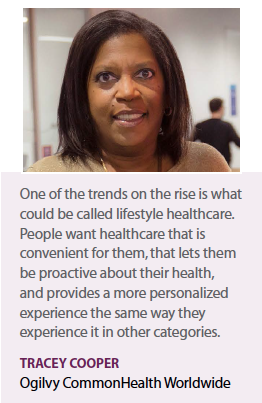 Senior Director, Commercial Analytics, Eisai
Senior Director, Commercial Analytics, Eisai
Advances in health technology will continue to enable improved patient care and create new avenues for scientific innovation.
Petra Jantzer — Luminary
Managing Director, Accenture
Digitization of healthcare and the power of big data are two big trends. The convergence of biology, data science, and digital technologies will drive medicines and health progress in this century as dramatically as the extraordinary achievements in physics, electronics, and engineering that revolutionized the last one.
Andrea Kretzmann — Luminary
Strategy, Fingerpaint Marketing
Genomics is finally hitting the main stage for consumers at the same time as broader scale adoption of wearables and integration with virtual assistants such as Alexa. The Helix Marketplace is creating a shopping experience to learn whatever you’d like about yourself on one set of data. People have unprecedented, and individual, information at their fingertips and are in more control of charting their health futures with and without their physicians.
Anila Lingamneni — Luminary
VP, Renal R&D, Baxter Healthcare, Baxter International
Technology advancements and emerging digital health innovations are driving integrated and personalized patient-centered healthcare transformation.
Nahrin Marino — Luminary
Deputy General Counsel Legal Regulatory, Astellas Pharma US
Digital heath is such a broad topic, but at its core it is the convergence of healthcare data and digital technology. Companies are using these digital resources in innovative ways to improve outcomes across the health sector. As lawyers, we have to embrace the use of digital technologies, partner with our digital teams early in the design phase, and provide guidance on the regulatory and legal requirements associated with these digital technologies.
Marilyn Marsh — Rising Star
National Sales Director, Publicis Health Solutions
The pharma industry must proactively embrace the coming hyper acceleration of technology, not only in R&D but in all aspects of commercialization. The HCPs of the future will depend on data streams and analysis as much they depend on the physical exam to diagnose and treat patients. Patients will be well-informed and prefer healthcare providers who use the best technological systems to treat their illnesses and maintain wellness. Wearables will provide continuous patient assessment and personalized medicine will become the norm. The pharma industry must partner with the healthcare community to meet the needs and requirements of patients of the future.
Nikkia Miller-Blakes — Luminary
Johnson & Johnson Technology, VP–Enterprise & Portfolio, Johnson & Johnson
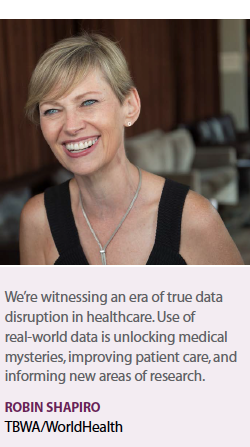 Technology, including digital health products and solutions, is transforming healthcare and creating opportunities. It is allowing patients to increase awareness and ownership of their health and well-being and healthcare professionals to diagnose and treat on a broader scale. It is also playing a key role in improving health outcomes through value-based approaches. Technology is at the center of the healthcare transformation, serving as a key differentiator and defining the customer experience.
Technology, including digital health products and solutions, is transforming healthcare and creating opportunities. It is allowing patients to increase awareness and ownership of their health and well-being and healthcare professionals to diagnose and treat on a broader scale. It is also playing a key role in improving health outcomes through value-based approaches. Technology is at the center of the healthcare transformation, serving as a key differentiator and defining the customer experience.
Angela Partisano, Pharm.D. — Rising Star
Global Medical Director, hATTR Amyloidosis, Alnylam Pharmaceuticals
Further advancement of programs and initiatives such as Google Health, machine learning, and IBM Watson will be critical in interrogating databases for applying clinical algorithms to diagnose patients with rare diseases and geotarget patients for trials. The advancement of digital therapeutics will provide an opportunity for biology and technology to further complement each other, while advances in social media platforms will allow advocacy groups to better understand and share patient experiences and burden of disease.
Jan Price — Luminary
Director, Women’s Healthcare and Neurology Medical Science Liaison Teams, Bayer
There is an explosion of new technology within our industry. In many ways this will shift the paradigm to more patient responsibility and self-advocacy, while providing new ways to engage with our healthcare providers. There are many examples of this, from the simple to the complex. Wearable devices, which help us monitor our own exercise, calorie intake, sleep patterns, etc., may have the ability to improve patient health. I work with an autoinjector that will remind patients to take their medication and track compliance, as well as provide a visual calendar and wellness tracker. Patients can also choose to send data to a healthcare provider.
Various health plans and systems are experimenting with different forms of telemedicine. This is a way to gain virtual access to physicians and enhance the timeliness and quality of healthcare delivery to patients. Innovative access can range from online diagnosis and treatment for basic illnesses that enable the patients to receive more immediate care from their homes, to hospital systems caring for patients remotely in rural areas by connecting directly to a patient’s mobile device.
Ponni Subbiah — Luminary
Chief Medical Officer, Indivior
Technology is playing an increasing role in healthcare. This will only accelerate as more people have access to tools such as smartphones and as technology continues to improve across the globe. Health services are already being delivered or enhanced through the Internet and related technologies. For example, instead of going to a bricks-and-mortar urgent care center for treatment of their flu symptoms, some people are opting to connect with doctors using telemedicine services. Another example is the use of activity trackers to monitor physical activity, which have expanded to track sleep, respiration, and other vital activities in real time. While data are going to exponentially increase, so will the challenge to identify credible and evidence-based information that can be used to help solve key societal issues from the impact of disease on communities to helping improve the quality of life of an individual. How do organizations use these disruptive technologies to achieve a mission that is of societal benefit? How do we, as a society, enable technology to bring about equity in access to quality care regardless of geographical location and socioeconomic considerations but at the same time protect the individual’s right to privacy? These are the questions for our time.
Sonia Shah — Rising Star
Senior Medical Director, The Scienomics Group, an Omnicom company
The consumerism of healthcare is a trend. Specifically, the proliferation of diagnostic technology and health information in the management of chronic diseases will empower patients to be more aware, informed, and in control of their own health.
Jodi Virkus — Rising Star
Oncology Marketing Indication Lead, Novartis Pharmaceuticals
The speed of change in technology, science, and medicine continue to outpace the ability of many of our customers to keep up. This creates the need for ever-increasing simplicity and solutions that make it easy for the healthcare system and physicians. In times when efficacy and safety are key, these are now expected, and additional solutions have to be provided to compete.
Sherri Zapinski — Luminary
VP, Global Procurement, Alcon, a Novartis company
Digital technology is opening up new ecosystems in healthcare. Not only is digital technology improving patient outcomes in eye care — it is rapidly changing how large companies such as Alcon are working with suppliers. Emerging technologies are breaking down silos between big companies and tiny start-ups to improve the supply chain in ways that were not possible even a few years ago.
Disruption
Stephanie Bostaph Martin — Rising Star
VP, Ketchum
Amazon is paving the way for companies — not traditionally known in healthcare — to disrupt the marketplace, bringing greater scrutiny to pricing, transparency, and access. The real question is whether this can have a widespread impact on the total cost of healthcare in the United States from the cost of prescriptions to procedures.
Tanesha Duncan — Rising Star
Executive Director, Technical
Commercialization, Celgene
If you look back 10 to 15 years, you can point to several industries that have been completely disrupted by the introduction of technological innovation that toppled major powerhouses and created opportunities for new entrants to exploit. Examples of companies that were formed out of these major shifts in industry dynamics include Amazon for retail, Netflix for entertainment, Spotify and Pandora for the music industry, and Blue Apron and HelloFresh for the grocery industry, to name just a few. The healthcare industry is one of the few industries whose operating model hasn’t materially changed in well over 20 years. Over the last few years, the healthcare industry has seen several technology companies entering the space during a time when the industry is ripe for disruption. The proliferation and accessibility of data and the technological advances that 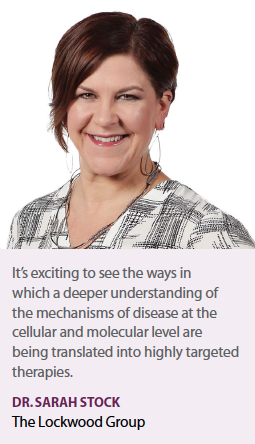 allow us to mine this data quickly and accurately will enable innovation across science, clinical development, access, reimbursement, and medical practice in the near future. Harnessing analytics in healthcare will be one of the major enablers that builds a bridge to personalized healthcare and innovative patient care solutions.
allow us to mine this data quickly and accurately will enable innovation across science, clinical development, access, reimbursement, and medical practice in the near future. Harnessing analytics in healthcare will be one of the major enablers that builds a bridge to personalized healthcare and innovative patient care solutions.
Jessica Hill — Rising Star
Senior Account Manager, Bulletin Healthcare
The entrance of Amazon into the pharmacy space could upend the industry, depending on the exact direction the company decides to go in. Consumers have increasingly more power in the healthcare marketplace and one can only imagine how the pharmacy model will change if consumers become accustomed to the convenience, responsive customer service, and fast shipping offered via Amazon in their health purchases. Additionally, consumers may come to expect the same level of service from their healthcare providers, insurers, and pharmaceutical companies.
Tracey Keele — Luminary
Partner, Risk Consulting, KPMG
Cross-sector disruption is changing how business is done. In a recent KPMG survey, two-thirds of CEOs said they believed that the next three years will be more critical for their operations than the previous 50 and that they were worried about their business models being disrupted. New entrants, consumer-centricity, and rapid technological advancement will reshape how the life-sciences industry operates. We are at a tipping point in the industry that will have far-reaching implications for patients, healthcare providers, and the cultural dynamics in the sector. Platform companies such as Amazon and Apple are quietly positioning themselves across the healthcare value chain, for example diagnostics, clinical research, and information capture, and distribution. The future holds great promise: better diagnostics; better, more targeted treatments; patient empowerment; and expanded access to care. Change will also threaten organizations that fail to pivot from traditional operating models. Anticipating, transforming, and reinventing will be essential to navigating this uncertain and dynamic environment.
Sonia Luaces — Rising Star
Partner, PwC
New sector entrants and emerging technologies continue to spur innovative partnerships through horizontal and vertical integration efforts, driving the sector to reevaluate existing business models, re-balance investments, and maximize cost structures.
Robin Shapiro — Luminary
Global President, TBWA\WorldHealth
We’re witnessing an era of true data disruption in healthcare. The use of real-world data is unlocking medical mysteries, improving patient care, and informing new areas of research. Healthcare technology companies such as Illumina are leveraging genomic data to decode rare diseases and identify new areas of health research. Artificial intelligence and real-world data are enabling better patient care and faster treatment decisions. Today, oncologists can leverage platforms such as CancerLinQ to track real-world data, making better and faster treatment decisions possible. The next frontier will take place when we find new ways to break down data silos, enabling easier sharing and collaboration in the name of better patient care.
Meg Smith — Luminary
VP, Clinical Operations, Quality and Regulatory Compliance, Stryker
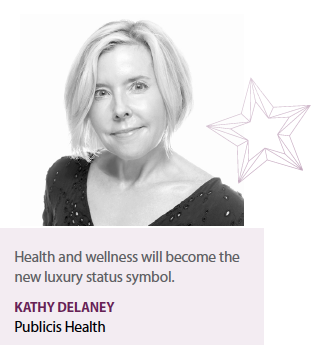 We have to drive cost out of healthcare. This is going to require overhauling the delivery model, which will be dependent on new technology to enable connectivity.
We have to drive cost out of healthcare. This is going to require overhauling the delivery model, which will be dependent on new technology to enable connectivity.
Cecilia Soriano — Luminary
VP, General Manager, Diabetes Care, BD
While there are multiple trends with significant impact to our industry, the one trend that is most material to the business I am currently in is the consolidation between retailers and payers, for example CVS and Aetna, as well as the evolving role of retailers such as Amazon in the healthcare space. This directly correlates to the rise in consumerism, population health management, technology/digital enablement of care, etc., which could have a significant impact on where, how, and when care is provided as well as how data flows between care settings, including access to patients at home.
Lisa Talbot — Luminary
Managing Director, Healthcare Strategy & Business Development, Marina Maher Communications
Amazon, Apple, Google, and Uber are being celebrated for successful disruption in consumer markets. They reimagined businesses creating services that became essential to our lives — before we even realized we needed them. Now, they are setting their sights on healthcare. These outsiders are unburdened by the way it’s always been done and that means they are free to imagine new, more convenient, and efficient business models that can transform how care is provided. And they have only just begun. I believe they are going to turn healthcare IT on its head in the best possible way.
Health & Wellness
Tracey Cooper — Rising Star
Digital Engagement Strategist, Ogilvy CommonHealth Worldwide
One of the trends on the rise is what could be called lifestyle healthcare. People want healthcare that is convenient for them, that lets them be proactive about their health and provides a more personalized experience the same way they experience it in other categories. Healthcare providers such as Forward and Parsley Health are offering easy access to private healthcare services in malls or shared office spaces. They’re merging the feeling of accessible healthcare that potential patients might encounter during their daily life at an urgent care center combined with the services and advanced health technology one would receive from a concierge doctor.
Kathy Delaney — Luminary
Global Chief Creative Officer, Publicis Health
Health and wellness will become the new luxury status symbol. I recently read a quote that said, “Feeling good is the new looking good." The article wasn’t in a medical journal, but in a lifestyle publication that primarily covers fashion. For an increasing number of people, possessing health and wellness quickly is becoming the ultimate signifier of fashion, luxury, and personal wealth. This trend is especially evident in 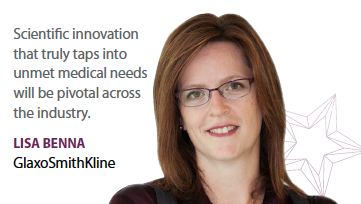 young millennial consumers, who value experiences over material possessions, and it’s a sentiment that has cascaded to older generations that are not only living longer, but also want to live better. And we are seeing this trend play out in the workplace as well. According to a study that Publicis Health fielded in 2017, 69% of Americans said they would rather have health and wellness perks, such as group fitness classes or in-office massages, than social perks like happy hours or company lunches. Health and wellness as a luxury status symbol is emblematic of a larger trend toward wellness intelligence. Consumers aren’t simply looking for treatments or pills to medicate them through disease, but instead they are making deliberate, conscientiously healthy choices that result in better overall wellbeing. Wellness intelligence provides people with the tools to make educated decisions about what we put in and on our bodies, and takes into account what we’re doing with our bodies, our minds, our souls, and our planet.
young millennial consumers, who value experiences over material possessions, and it’s a sentiment that has cascaded to older generations that are not only living longer, but also want to live better. And we are seeing this trend play out in the workplace as well. According to a study that Publicis Health fielded in 2017, 69% of Americans said they would rather have health and wellness perks, such as group fitness classes or in-office massages, than social perks like happy hours or company lunches. Health and wellness as a luxury status symbol is emblematic of a larger trend toward wellness intelligence. Consumers aren’t simply looking for treatments or pills to medicate them through disease, but instead they are making deliberate, conscientiously healthy choices that result in better overall wellbeing. Wellness intelligence provides people with the tools to make educated decisions about what we put in and on our bodies, and takes into account what we’re doing with our bodies, our minds, our souls, and our planet.
Elsie DiBella — Luminary
VP, Biologics Process and CMC Development, Momenta Pharmaceuticals
A major trend in the healthcare industry is likely to be around health and wellness, specifically in the area of nutrition. It is estimated that nearly half of all Americans suffer from at least one chronic disease. We as an industry have done a tremendous job treating the symptoms of these illnesses. But there needs to be a shift in focus in our healthcare system from treating symptoms to preventive action. And to think that the preventive action could be as simple as getting more whole food and less processed food.
Renee Hall — Rising Star
Executive Director, Head of Commercial Excellence, Boehringer Ingelheim
The effect of animals on people’s lives, and the larger framework of individual “whole health" is a dynamic trending area. The described benefits of being a pet-owner, and how pet ownership contributes to overall human health, is important in today’s society, and to me personally. The Human Animal Bond Research Institute (HABRI) reports that the impact of pet ownership will save an estimated $11.7 billion in healthcare costs this year, and that 80 million American households likely experience the healthy benefits of having a pet in the home. Additionally, our growing reliance on production animals and the provenance of our food and protein sources will be an increasingly important topic in the years to come. When viewed in totality, there exist linkages to total wellness in humans, derived from responsible interactions with animals.
Kelly MacDonald — Rising Star
Director, Commercial Finance and Technical Accounting, Ironwood Pharmaceuticals
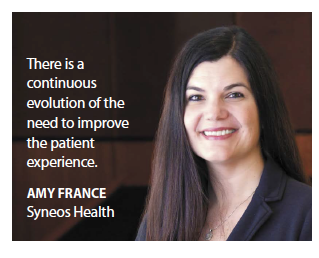 I believe that a continued shift in focus toward prevention rather than treatment will also impact the overall industry significantly. This shift will continue to evolve over time and ultimately will lead to a more efficient and cost-effective healthcare infrastructure.
I believe that a continued shift in focus toward prevention rather than treatment will also impact the overall industry significantly. This shift will continue to evolve over time and ultimately will lead to a more efficient and cost-effective healthcare infrastructure.
Innovation
Lisa Benna — Luminary
Senior VP, HR, GlaxoSmithKline
Scientific innovation that truly taps into unmet medical needs will be pivotal across the industry. This innovation coupled with real world evidence, especially in the U.S. marketplace, will play a critical role.
Sonal Bhatia — Rising Star
VP, NA Regional Medical Affairs Lead, Rare Diseases, Pfizer
Gene therapy and gene editing-like innovation will start scaling up more aggressively than we have ever witnessed before. Textbook concepts will become scientific and commercial reality more rapidly. The concept of cure will be re-defined because of these therapies and as such, medicine will become increasingly personalized. The associated infrastructure for the delivery of medicine will also have to keep up with the innovations. In the coming decades, gene editing could revolutionize the treatment of different diseases such as neurological disorders or cancers. This approach enables healthcare providers to alter/replace the problematic gene to produce a new therapeutic protein or silence mutant cells.
Renata Campos — Rising Star
Area Head LATAM & President, Brazil, Takeda Pharma LTDA
In the coming years, the pharmaceutical companies that offer not only new solutions to the medical unmet needs, but those that can improve the patient experience will stand out. Technology can help in this way, which shows a great opportunity for pharmaceutical companies to be even more innovative in research and  development, to strengthen continuous medical education, and, consequently, to improve patients’ journeys.
development, to strengthen continuous medical education, and, consequently, to improve patients’ journeys.
Susan Farkas — Rising Star
Commercial Business Director, AstraZeneca Pharmaceuticals
Scientific innovation will continue to be critically important so that life-changing medicines can be brought to market and enable patients to receive their best possible outcome.
Jennifer Jackson, Ph.D. — Luminary
Senior VP, Global Regulatory Affairs & Quality Assurance, Tesaro
In the United States, innovative drugs for serious and rare diseases will be sped to market as the FDA shifts to an integrated approach to addressing disease. In response to the advance of precision medicine, the FDA will move away from its traditional operating structure, creating multi-disciplinary teams grouped by their deep understanding of a disease. The Oncology Center of Excellence is the first such grouping that was formed in 2017. Breaking down traditional silos, the Center of Excellence was designed to increase communications and collaboration within the regulatory agency and with external stakeholders, including patients, advocacy groups, and researchers. Patients have benefited from this new oncology-specific center through the approval of innovative products, including two cell-based gene therapies and the first biomarker-defined, pan-tumor therapy. The FDA has plans to expand this center of excellence model to other diseases such as immunotherapy and neuroscience.
Tara Mautone — Rising Star
Senior Director, Chief of Staff, President, Daiichi Sankyo
Clinical and technological innovation, specifically around immunotherapy, gene therapy, and wearable digital devices will continue to be a trend. How these types of innovation shape the future of healthcare will largely depend on how prepared we are to respond to all of the unknowns that accompany such innovation, and how well we anticipate the consequences both politically and economically.
Ana Dolores Román — Rising Star
PEH Country Manager, Peru, Bolivia, and Ecuador, Pfizer
All businesses that want to stay relevant, survive competitive pressures, and best serve their customers must innovate to face rapid changes, uncertainty, and new dynamics. Innovation is essential to bringing value to 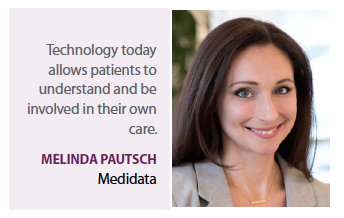 patients, and being more purposeful and deliberate about innovation is vital to driving growth. Technology is changing the way we approach our research and development activities since medicines are among the most powerful tools we have for patients to treat, cure, and manage chronic and life-threatening diseases. We must continue to advance innovative medicines. In recent years, developments such as biosimilars, gene therapy, and precision medicine have been effective at treating many of these diseases.
patients, and being more purposeful and deliberate about innovation is vital to driving growth. Technology is changing the way we approach our research and development activities since medicines are among the most powerful tools we have for patients to treat, cure, and manage chronic and life-threatening diseases. We must continue to advance innovative medicines. In recent years, developments such as biosimilars, gene therapy, and precision medicine have been effective at treating many of these diseases.
Kunbi Rudnick — Rising Star
Director, Global Marketing, Merck & Co.
Innovate or die — the healthcare industry has to be willing to take prudent risks that do not impact patient care. We need to consider smarter, more efficient processes from discovery through to patient interaction. The companies that take big leaps will be the ones to survive these uncertain times.
Janet Smith — Rising Star
Director, Enterprise Accounts,
Healthcare, UPS
Today’s healthcare customers demand options that allow them to receive their medications, medical products, and devices when and where they need them.
Medical Records
Jennifer Broxmeyer — Rising Star
Director of Compliance and Associate General Counsel, athenahealth
Interoperability has taken far longer than it should, but with pressure from Congress and a proposed framework from ONC, vendors are moving toward interoperability of medical records. If done correctly, it should lead to better care, reduce duplicate testing, and save lives.
Patient Engagement and Patient-Centricity
Edith Eby — Luminary
VP, Pfizer
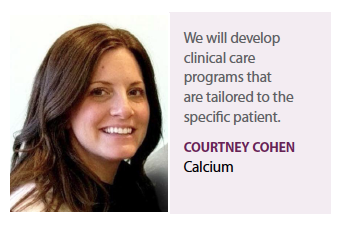 Patients are more engaged than ever before in their healthcare decisions. The Internet has allowed access to more information for patients. It is critical for us in the industry to enable the provision of credible medical information for patients to avoid the misinformation that is available on so many sites. In addition, we must identify innovative ways to include and share the patient voice throughout the lifecycle of any new therapy for patients.
Patients are more engaged than ever before in their healthcare decisions. The Internet has allowed access to more information for patients. It is critical for us in the industry to enable the provision of credible medical information for patients to avoid the misinformation that is available on so many sites. In addition, we must identify innovative ways to include and share the patient voice throughout the lifecycle of any new therapy for patients.
Jovelle Fernandez — Rising Star
VP, Japan Medical Officer and Head, Japan Medical Affairs, Takeda Pharmaceuticals
There has been a lot of buzz about patient-centricity, and that everything that the pharma industry does is dedicated to the patients. If we remain focused on the patient, and if the patient is front and center of everything that we do, we will build trust with society, we will be able to reinforce the industry’s reputation whereby society sees us as a partner to help prevent diseases or help alleviate symptoms and manage diseases. Eventually, business will follow. We need to put ourselves into the shoes of patients and continue to listen to them, their families, and their caregivers and truly understand what their needs are.
Amy France — Rising Star
VP, Finance, Syneos Health
There is a continuous evolution of the need to improve the patient experience. Patients across generations continue to have access to more information through advancement of technology. Patients find themselves with more questions and options. Patients expect more value for the same or less cost. Healthcare providers will continue to navigate how to differentiate themselves as an outstanding provider of care while also balancing the continued challenges of rising costs.
Cecile Guegan — Luminary
VP, Finance Global Oncology and Medicine Development, Pfizer
Patients will continue to be more and more informed and active participants in their care. The patient voice and early engagement will become paramount in designing and conducting trials that are more widely accessible, more tolerable, and less burdensome. More engaged patients will be looking for beyond-the-pill support to accompany them in actively managing and living with their disease. Companies need to focus on patients in every area of the business because it’s the right thing to do.
Emma Howe — Rising Star
Marketing Director, Upper Respiratory, Health BU, RB US, RB
It is fair to say that the rapid increase of chronic illnesses is going to continue to put the healthcare system under pressure. In response to this environment, more and more people will become active participants in their own healthcare. Industry will play a key role in enabling better self-care. This will happen first by championing increased consumer access to OTC treatment options through both switch and innovation, and secondly, by providing access to better quality health information, easy to use diagnostic tools, and 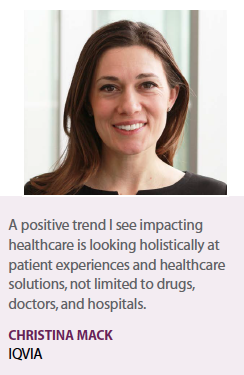 technology, which will allow consumers to better understand and track their health stats. Overall, I expect we will see consumers become even more connected to their health and I hope more confident in their ability to impact it for the better.
technology, which will allow consumers to better understand and track their health stats. Overall, I expect we will see consumers become even more connected to their health and I hope more confident in their ability to impact it for the better.
Sangita Iyer — Rising Star
Director, FP&A, Horizon Pharma
As the healthcare system continues to evolve, we will see more companies moving toward a robust patient services model that goes beyond treatment and focuses on the entirety of the patient journey. Whether through technological advancement, real-time data assimilation through apps and social media platforms, companies will have to adopt strategic ways to connect with the patient/caregiver community as these communities become more empowered.
Christina Mack — Rising Star
Senior Director of Epidemiology, IQVIA
A positive trend I see impacting healthcare is looking holistically at patient experiences and healthcare solutions, not limited to drugs, doctors, and hospitals. While drugs and devices are often the solution, how they are delivered and what they are delivered in, in conjunction with alternative medicine, increased mental health, patient education and support, and now, connected health may enhance what traditional medicine can do. Perhaps most importantly, these options enhance the experience of patients as they go through the medical system. How can we creatively focus on every aspect of the patient? Bringing it one step further into research, how can we generate evidence that helps us understand what is most effective for each patient?
Kellie Malloy — Luminary
Executive VP, Syneos Health
Patients expect more from healthcare providers, and that is creating monumental change for our industry. Technology has made our lives easier, including how we access and assess our personal healthcare. It’s time for us to change the conversation on healthcare and make participating in clinical trials part of what a patient chooses.
Cari Nicholson — Rising Star
Executive Director, Strategic Account Management, VMS BioMarketing
As consumer-driven healthcare continues to expand, patient-centricity must continue to be the primary focus for the healthcare industry. After my son was diagnosed with Type 1 diabetes a year ago, I experienced the many different spokes of healthcare from a very real, personal perspective. The process for understanding the impact of a new diagnosis and therapy regimen along with insurance coverage implications was mentally and emotionally exhausting. I experienced the current landscape to be fragmented; I had to rely on sheer determination to pull together the necessary pieces of the puzzle when insurance originally declined our ER visit due to a miscoding and when I showed up to the pharmacy and got hit with an extraordinarily large subtotal. While consumers today have more options and access to information than ever before, the journey is often still convoluted and difficult to navigate. A patient-centric approach, with increased communication, support, and training, must continue to be the primary focus and driver. Aligning upon what it means to successfully achieve patient empowerment and how to streamline the experience must continue to be the endpoint across the different stakeholders within the wide lens of healthcare.
Melinda Pautsch — Rising Star
Director, Strategic Accounts and Medical Device/Diagnostic Sales, Medidata Solutions
Patients are more engaged in their healthcare than ever before. Technology today allows them to understand 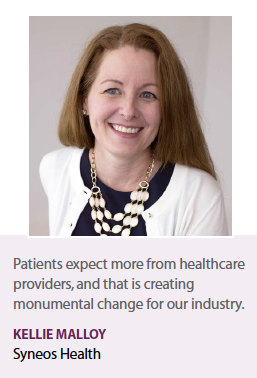 and be involved in their own care, helping pharma and device companies have an even bigger impact on the patients they treat.
and be involved in their own care, helping pharma and device companies have an even bigger impact on the patients they treat.
Emily Smith — Rising Star
VP, Associate Creative Director, Concentric Health Experience
By creating health experiences attuned to our customers’ needs, we have the ability to not only develop positive relationships, but also to solve serious health problems.
Amanda Strong — Rising Star
Group Medical Copy Supervisor, Giant Creative Strategy
As technology continues to disrupt traditional marketing, a cohesive brand experience is becoming evermore important. Gone are the days of spun data and a good sales pitch. Customers exist in a surround-sound world and engage with brands across multiple channels, directly and indirectly. The use of multichannel storytelling with a unified brand narrative that inspires action will be critical to meaningful customer engagement, conversion, and loyalty as we move into the next era of healthcare marketing.
Personalized Health
Courtney Cohen — Rising Star
Associate Creative Director, Calcium USA
One trend in healthcare will be that we will continue to see the development of therapies tailored to the individual genetic makeup, needs, and everyday lifestyle of the patient. We will develop clinical care programs that are tailored to the specific patient. This will help to improve patient outcomes.
Maggie Daniels — Luminary
National Sales Director, Corporate Accounts, Roche Diagnostics
Personalized healthcare will continue to impact a broader range of patients. A wider range of patients’ treatment plans will be customized according to individuals’ own genetic information.
Binodh Desilva, Ph.D. — Luminary
VP, Bristol-Myers Squibb
A new era in personalized medicine will emerge as CAR T-cell therapies show promise and the scientists gather more data from exploring the human microbiome. What we think we know about personalized medicine and the consumer’s approach to their healthcare needs will take a quantum leap, when the expansion of research on exploring the human microbiome and the utility of CAR T-cell therapies become more widespread. Current personalized medicine is mostly based on one’s genetic makeup. The study of the microbiome of a person will shine the light on their metabolism and digestive process. The combination of the genetic and metabolic profile of an individual w be a profound combination for treatment of a disease.
The past few years brought us immunotherapy medicines to fight cancer, and the promise of a “living drug" as it is called for CAR T-cell therapy will bring a new treatment platform for certain other cancers. I certainly did not imagine that a cure for cancer would be developed during my lifetime. I am truly grateful to be a scientist in this era of exciting research and development in bringing life-changing medicines to patients.
Kathryn Payne — Rising Star
Senior VP, Corporate Affairs, AMAG Pharmaceuticals
Customizing medicine — both treatment and service — to the needs, genetic makeup, and lifestyle of individuals will continue to be an important trend in healthcare, leading to more effective interventions for common diseases and better health outcomes. Related to this trend is the increase in patient demand for an improved patient experience, from healthcare companies and providers alike.
Vanita Sharma — Rising Star
Senior Director, Patient Advocacy & Public Policy, Strongbridge Biopharma
Harnessing the power of one’s own immune system to treat diseases — efficiently and effectively — will continue to be a trend in healthcare that will be revolutionary and transformational. Immuno-based therapies — not only for infectious diseases and oncology, but a variety of unmet medical needs — will empower the patient’s own immune system to fight the disease. This will lead to faster treatment times, possible cures, less reliance on medicines that are disease-worsening, ineffective, and/or unsafe, and offer potential cost-savings to the overall healthcare system. Helping patients embrace this innovative platform, and its overall benefits, will lead to personalized medicine.
Sarah Stock, Ph.D. — Rising Star
VP, Group Scientific Director, The Lockwood Group
Personalized medicine is probably too broad a term, but it’s really exciting to see the ways in which a deeper understanding of the mechanisms of disease at the cellular and molecular level are being translated into highly targeted therapies, as well as how biomarkers are enabling clinicians to better predict which therapies will be most effective for certain patients.
Pricing and Value
Anne Brooks — Rising Star
Senior Director, Oncology Marketing, Teva Pharmaceuticals
Patients are demanding more transparency around healthcare pricing, particularly for healthcare services. What can the pharmaceutical industry do to demonstrate transparency in pricing to patients more proactively throughout the supply chain, so that patients can make more informed healthcare decisions? Healthcare reimbursement is moving away from volume and more toward value, seen in many emerging alternative payment models such as the Oncology Care Model. What value offerings actually drive better patient outcomes, and does an enhanced patient experience create value?
Haita Makanji, Pharm.D., R.Ph. — Rising Star
VP, Clinical Strategy and Programs, Magellan Rx Management
Specialty drug costs continue to rise on the pharmacy benefit and medical benefit, where the number of billion-dollar drugs is expected to increase by 42% by 2021. Now, more than ever, health plans must engage in new, innovative, and targeted cost-containment strategies to control the specialty drug costs holistically across both the medical and pharmacy benefit.
R&D
Neeta Amin — Rising Star
Executive Director, Clinical Lead/Clinical Science Head, Pfizer
There is a need to identify innovative agents, with high confidence, earlier in clinical development. We also need to design and execute trials using clinically meaningful endpoints that can be extrapolated to pivotal study-endpoint(s), with the ultimate goal being to further reduce attrition beyond Phase IIa.
Lisa Bakazias — Luminary
VP, Global Operations, Manufacturing Strategy, West Pharmaceutical Services
The proven efficacy of targeted biologic therapies, particularly in the area of cancer treatment, is forcing pharmaceutical companies to deliver research and development in ever-differing ways than in the past. Delivering these medicines to patients effectively also requires innovative approaches. As the industry further prepares for this class of exciting new therapies, our industry must embrace new models to manufacture and deliver these medicines to patients.
Kristi Cooper — Rising Stars
Director, Learning and Development, Novo Nordisk
The rise in obesity rates puts patients at risk for other concomitant illnesses. Obesity, along with comorbid conditions put a strain on healthcare spend.(PV)
~~~~~~~~~~~~~~~~~~~~~~~~~
HBA Luminaries: Leadership Is…
Lisa Bakazias
VP, Global Operations, Manufacturing Strategy, West Pharmaceutical Services
Leadership is: Courage
In my career, I have been driven to seek solutions and innovative ways to transform personally, as well as transform my team. My goal is to look to the future and ensure my team and my company are competitive in the long term.
Lisa Benna
Senior VP, HR, GlaxoSmithKline
Leadership is: Authentic and Inclusive
I believe companies and leaders can get outstanding results by creating an inclusive culture, where all employees feel their ideas and thoughts are important and add to the business and underlying culture. As a leader, I believe in being authentic, even if that means being unpopular or going against corporate norms. Through inclusion and creating an environment where people can be their best, every day, businesses see amazing culture transformations and business results.
Heidi Casaletto
VP, Business Fields-Transfusion Medicine, Business Fields Marketing, Ortho Clinical Diagnostics
Leadership is: Passionate
I have strong belief in doing something that leaves a lasting, positive impression on the world we live in. In the simplest form this shows itself in my passion to improve the quality of life.
Maggie Daniels
National Sales Director, Corporate Accounts, Roche Diagnostics
Leadership is: Empowering
Leading teams, departments, a division, or a company means you have to trust and empower your teams to develop strategies and execute to achieve the mission and goals. My best work came from being entrusted to achieve the goal and my focus as a leader is to do the same for those that I lead.
Kathy Delaney
Global Chief Creative Officer, Publicis Health
Leadership is: Empathy and Generosity
To me, leadership is all about feeling and doing. As leaders, our essential duty is to ensure that we genuin ely and deeply understand everything about our people, our clients, and our work. Having true empathy can’t be faked, and when it’s real, people will follow a leader to the ends of the earth. Because of the gift of faith that’s bestowed upon leaders, it’s also our responsibility to consistently demonstrate generosity by giving our time, spirit, and knowledge. This becomes a virtuous cycle: empathy breeds generosity and generosity breeds empathy, and so on.
Binodh Desilva, Ph.D.
VP, Bristol-Myers Squibb
Leadership is: Enterprise Mindset
Leaders need to be mindful of what is best for the organization versus individuals or the group.
Elsie DiBella
VP, Biologics Process and CMC Development, Momenta Pharmaceuticals
Leadership is: Inclusive
I have always believed that a team is better than the sum of its parts. When I encounter obstacles on my team, such as one group not understanding what the other is doing and why they’re doing it, I find a way to bring those two groups together on a project that encourages shared learning. I also believe that everyone can contribute to making the group more effective and create an environment where all levels are willing to bring forth their own ideas and then are willing to take action on them. This last piece is important — when I empower people it’s not just about bringing forward ideas that management then takes over and implements. It’s having those with the ideas working with others to determine the best plan for implementation with the team, with the support they need from management.
Edith Eby
VP, Pfizer
Leadership is: Authentic
Authentic leaders are genuine and I believe I am genuine. I have been told that I am a bad poker player. As an authentic leader, I strive to demonstrate behaviors tbat enable others to trust in me; I take ownership and have courage to challenge the status quo.
Rachel Frizberg
Commercial Director Region Europe, Roche
Leadership is: Collaborative
Intentional relationships are the fuel of transformational leadership. You need to develop a genuine understanding of the individual needs of each colleague and purposefully support their growth in line with the strategic goals of the business.
Coleen Glessner
Senior VP and Chief Quality Officer, Alexion Pharmaceuticals
Leadership is: Never Settle
Time is finite. Why would you waste your limited time by settling for anything less than the best? Each day, we are each required to make choices. These choices have unintended consequences on our business and for our patients. Choosing excellence enables delivery of more than we ever thought we could. As a leader, I endeavor to inspire teams to never settle and to choose excellence.
Cecile Guegan
VP, Finance Global Oncology and Medicine Development, Pfizer
Leadership is: Integrity
Being honest and fair to colleagues and peers creates a productive work environment in which everyone can contribute and grow. Leaders need to position the interest of the enterprise first, before individual interest and office politics, to avoid bias in decision making.
Jennifer Jackson, Ph.D.
Senior VP, Global Regulatory Affairs & Quality Assurance,
Tesaro
Petra Jantzer
Managing Director,
Accenture
Leadership is: Authentic
Authentic leadership to me means being self-aware and genuine; mission-driven and focused on results; focused on the long-term; and leading with the heart.
Tracey Keele
Partner, Risk Consulting,
KPMG
Leadership is: Imperfect
I’ve always felt that the best leaders are those who are relatable, accessible, and real. We are all human, we all have flaws — whether acknowledged or not — and have all had some stumbles along the way. Our humanity is what connects us and it is in those moments of imperfection that we often learn, grow, and inspire the most. My imperfections not only drive me to learn more and be better, but help me relate to my team, understand the challenges they face, and ease the path to leadership for others.
Andrea Kretzmann
Strategy, Fingerpaint Marketing
Leadership is: Proactive and Passionate
I love this business and am always looking to push works and our collective achievements. Good enough is not good enough.
Lauren Lewis
Executive VP, Managing Director,
McCann Torre Lazur
Leadership is: Passionate and Driven
Leaders approach everything with full zest and zeal, with dedication and focus. They also are driven with a goal in mind; there’s no stalling, stopping, or short cuts.
Anila Lingamneni
VP, Renal R&D, Baxter Healthcare,
Baxter International
Leadership is: Authentic
I strongly believe that authenticity drives trust and belief, which are critical for building a workplace that is not a job but a career for your team.
Kellie Malloy
Executive VP, Syneos Health
Leadership is: Caring
By keeping the patient at the center of what we do, caring becomes the DNA of our work. I have been honored to partner with wonderful clients, lead fantastic global teams, and collaborate with excellent investigative sites throughout my career. I have found that the best outcomes come from going above and beyond what is expected, and have been able to do that by grounding to the importance of what we do. The tools and know-how are a must, but support and caring make a difference when the unexpected happens.
Nahrin Marino
Deputy General Counsel Legal Regulatory, Astellas Pharma US
Leadership is: Connecting
During my career I’ve learned a number of lessons and a few have made a big impact. First, it’s critical to connect with people at all levels of the organization. Second, it’s important to be able to respond to the evolving business environment, to remain open, and to be willing to learn. Third, good solutions are only achieved through partnership and understanding of each unique perspective and goal. Fourth, it is important to foster an environment of honesty in providing feedback, balanced with trust and respect. Fifth, a good leader must actively participate as a team member to contribute to overall success. It takes the whole team, working together, to drive to success.
Jymme McQuillan
Executive Director, Operations,
Quest Diagnostics
Nikkia Miller-Blakes
Johnson & Johnson Technology, VP – Enterprise & Portfolio,
Johnson & Johnson
Leadership is: Head and Heart
Leaders have a natural ability to lead with both their head and heart while keeping them in sync and bringing their best every day.
Jan Price
Director, Women’s Healthcare and Neurology Medical Science Liaison Teams, Bayer
Leadership is: People Development
It is a leader’s responsibility to hire, retain, and develop talent. Employees want to be valued and be part of a greater vision. I make it a priority to understand the strengths of my teammates and to focus on providing them with opportunities to enhance those strengths. Whether that is professional development, special projects, or opportunities for visibility, I personally invest in each person’s growth and success. This has helped to create a culture of mutual success within a team where each individual’s unique skills add to the whole.
Rosemary Rebuli
Global Head of Trial Management,
Novartis Pharmaceuticals
Leadership is: Integrity
I have found the most formative moments in my career are those when I have had my sense of right and wrong challenged or tested. For me having a career in this industry is a vocation and a privilege and it carries with it great responsibility. Leadership has to be a verb and not a noun and continuously striving to act in concordance with core beliefs is essential to the relationship I have with my team, as well as the impact we as a team have on the organization, and ultimately on society. I work to ensure my word and the word of my team carries weight and engenders trust.
Dawn Rogers
Senior VP, Human Resources,
Pfizer
Robin Shapiro
Global President,
TBWA\WorldHealth
Leadership is: Continuous improvement
Every day I ask: “What can I do better? What can we do better?" Creating a culture of continuous improvement and personal accountability leads to stronger engagement and better results.
Meg Smith
VP, Clinical Operations, Quality and Regulatory Compliance, Stryker
Leadership is: Collaborative
and Trusting
I believe that, as a leader, if you work collaboratively with your team to establish a clear, simple vision, and mission, you have to give them your trust to carry out the vision and mission with their teams. Leaders develop from learning how to set direction and create execution plans for sustained change.
Cecilia Soriano
VP, General Manager, Diabetes Care, BD
Leadership is: Authentic
I am a very genuine, open person who believes in transparency and trust. I think impactful teams are built on a solid foundation, a common core of shared values, and a strong sense of purpose in order to thrive and deliver results.
Ponni Subbiah
Chief Medical Officer, Indivior
Lisa Talbot
Managing Director, Healthcare Strategy & Business Development, Marina Maher Communications
Leadership is: Fearless
If you do not feel a little uncomfortable, the work is probably not good enough. Nothing extraordinary comes from being comfortable. To truly make a difference, we have to be brave enough to step out of our comfort zones and do something that has never been done before. I challenge all of my teams to adopt some level of fearlessness and push themselves beyond what they think they’re capable of. I’m rarely disappointed. Together we are better — an individual can come up with a good idea; a team can make it a great idea.
Onelia Ann Vera
Head Counsel, Hematology, Shire
Leadership is: Results-Oriented
I motivate myself and my cross-functional teams to achieve patient-centric results that will ultimately benefit patients. The patients are at the center of everything we do. If we can achieve the right results for patients within a compliant framework, we achieve our vision and are ultimately a successful company.
Erica Yahr
Executive VP, Executive Strategy Director,
McCann Health
Sherri Zapinski
VP, Global Procurement
Alcon, a Novartis company
Leadership is: Collaboration
Procurement is often at the center of competing interests between various departments in any large company. My goal is to always be respectful of everyone’s unique concerns and then shift the group’s focus to the bigger picture. It is much easier to gain alignment around a clear, unifying vision than forcing each party to negotiate solely based on his or her own individual needs.
Litao Zhang, Ph.D.
VP, Leads Discovery & Optimization,
Bristol-Myers Squibb
Neeta Amin
Executive Director, Clinical Lead/Clinical Science Head, Pfizer
Leadership is: Tough But Fair
Innovation needs a setting that encourages new thinking, is in an environment that aims for more than what was thought possible/doable, sets new norms constantly, but equally so recognizes that best breakthroughs are a combination of both wins and so called “losses."
Jennifer Anderson
Director, Operations, Performance Health
Leadership is: Collaborative-Learner
I have a thirst for knowledge and believe that you will inherently improve yourself by learning and listening to what goes on around you; that understanding the other person’s point of view or how people think about you, is as important or more important, than how you think of them. I always try and make time for self-improvement, whether it be personal or professional, it always leads to growth.
Sonal Bhatia
VP, NA Regional Medical Affairs Lead, Rare Diseases, Pfizer
Leadership is: Grit
Grit is the ability to work hard for a long period of time toward a goal; to persevere, overcome, and keep moving forward in the face of adversity, failure, rejection, and obstacles. Along the way a leader will face countless challenges, failures, and setbacks that will become roadblocks unless they find a way forward. Positive leaders have grit and find a way to navigate the roadblocks or run through them to move closer to their vision and goal.
Stephanie Bostaph Martin
VP, Ketchum
Leadership is: Empowerment
I am where I am today thanks to leaders who have empowered me to embrace new challenges — from learning the business operations of a small company to switching my PR specialization to healthcare. This is the kind of leader I strive to be: one who values mentorship, believes my team can accomplish many tasks above their levels and provides the runway needed to reach their greatest aspirations.
Vanessa Breschard
Executive Creative Director, Health & Wellness Partners
Leadership is: Committed
As a leader I am committed to keeping my team informed and relatively stress-free. I believe in seeing the big picture before diving in to any project and leading my team down a path of darkness and uncertainty. With our shortened work deadlines and expanding project scopes it is important to lead the charge knowing that we have left no stone unturned. I am all-in, ready to help and guide however and whenever necessary. I am committed to instilling in my team a passion to go above and beyond with their creativity.
Anne Brooks
Senior Director, Oncology Marketing, Teva Pharmaceuticals
Leadership is: Authenticity
Leaders are humans too. When it’s clear to others that I am who I am, I say what I think, I’m humble, and I’m willing to admit mistakes, people respond positively with trust and appreciation.
Jennifer Broxmeyer
Director of Compliance and Associate General Counsel, athenahealth
Leadership is: Empathetic
I build every working relationship on mutual respect and common purpose. My role requires frequent collaboration with business and product teams, and the best solutions come from truly understanding what’s motivating them and what their objectives and obstacles are. When there are disagreements or difficult decisions, we have that common foundation to ground us.
Renata Campos
Area Head LATAM & President, Brazil, Takeda Pharma LTDA
Leadership is: Resilience
Leaders need to be open to learn from mistakes and successes, value diversity, and get out of their comfort zone, delivering the extra mile — always. Enjoy changes with proactive and positive attitudes. Leaders also need to be flexible to manage diverse and multiple situations with a high level of urgency and agility.
Jessica Coffey
Director, National Markets Account Management,
Cardinal Health
Leadership is: Team-focused
My favorite aspect of recent roles I’ve held is managing many dedicated, creative and hard-working team members. They’ve taught me so much about motivation, building a culture, coaching for performance, strategizing and prioritizing, and about how to have a lot of fun celebrating successes at work. I’m so thankful to have worked with many wonderful teammates.
Courtney Cohen
Associate Creative Director, Calcium USA
Leadership is: Innovator
As a graphic artist, I am both a leader and an innovator who helps others on my team create the vision that we are looking for. It’s all about the team, the work, and learning to work together and trust each other.
Kristi Cooper
Director, Learning and Development, Novo Nordisk
Leadership is: Authentic
I provide thoughtful and truthful input to situations, regardless of hierarchy.
Tracey Cooper
Digital Engagement Strategist, Ogilvy CommonHealth Worldwide
Leadership is: Relationship/Team Builder
I look for ways to bring teams together for the common goal of having the best of what the team offers to our clients. We work across multiple disciplines often; it helps when we can all get to the finish line together.
Dana Dodzik
Senior Director, Corporate Communications, Lundbeck
Leadership is: Openness and Transparency
I believe that being open with your team and sharing as much information as possible allows everyone to do his or her job better. Sharing important context and information helps teams have the right information at the right time to make the best decisions on behalf of the business. It fosters responsibility and ownership for the work, thereby increasing engagement and propelling a business forward. Great business plans and strategy are not enough — alignment and understanding of the strategy, and how to deliver upon it, can push a company over the top.
Tanesha Duncan
Executive Director, Technical Commercialization, Celgene
Leadership is: Integrity
For me, integrity is about being open, honest, trustworthy, and accountable. I aim to achieve this by always prioritizing the people first and foremost, and holding myself accountable for my own words and actions.
Sophie Dutilloy
DVP Abbott Diabetes Care, EMEAP, Abbott
Leadership is: Adaptable
My experience working in multiple countries, with different cultures, and across various businesses allows me to find and implement new business solutions and thrive in a volatile, complex, and evolving healthcare world.
Susan Farkas
Commercial Business Director, AstraZeneca Pharmaceuticals
Leadership is: Trust and Transparency
It’s an honor and a privilege to lead teams. To embody and create an environment of trust and transparency allows everyone to bring their best self to work and maximizes engagement.
Margaret Faul
Executive Director, Process Development, Amgen
Leadership is: Engaged
Being engaged with my team members allows me to understand their problems and work with them in delivering solutions, rather than just viewing what’s happening from the sideline, allowing greater connectivity and a more productive work environment.
Jovelle Fernandez
VP, Japan Medical Officer and Head, Japan Medical Affairs, Takeda Pharmaceuticals
Leadership is: Enable
I always try to live by my mission in life, which is to be an instrument to enable individuals to be better than the best – and that best is something that is “need to be best" rather than “want to be best." This is built upon what I look back to and what I am grounded on. I am grounded on being an instrument to make a difference to somebody else’s life, to enable the other individual to a better person, and bring out the best in that person.
Joy Fitzgerald
Chief Diversity Officer, Eli Lilly and Company
Leadership is: Action-Oriented
At Lilly, we are long past the awareness stage of our diversity and inclusion journey. We are taking action and measuring results. This perfectly fits my leadership style. I leverage my deep knowledge of the company, its practices, its people — and its organizational habits — to solicit appropriate input, chart a course and move. Our business is changing fast, and I’m helping to lead the behavior changes necessary for success.
Colleen Flesher
Area VP Sales, Johnson & Johnson
Amy France
VP, Finance, Syneos Health
Leadership is: Collaborative
I believe successful organizations are ones where employees collaborate continuously and respectfully not only with their own internal team, but also with the teams across their organization. I strive to be an example of this quality by making my cross-functional interactions meaningful. I want those interactions to build a foundation for trusting relationships that in the end hopefully yield results internally and externally for the organization.
Betsy George
Director, Medical Affairs, Operations, Ferring Pharmaceuticals
Leadership is: Accountability
My strongest leadership quality is accountability. I hold myself accountable for my actions and outcomes, positive or negative. I also empower my team to do the same, by taking risks and admitting failures and mistakes so that we can learn and grow together.
Inna Glozman
Senior Director, Commercial Analytics, Eisai
Leadership is: Empowering
I empower my team to drive informed business decisions through integrated, actionable insights and strategic recommendations. As a team leader, I set high standards and provide the support necessary to achieve them.
Renee Hall
Executive Director, Head of Commercial Excellence, Boehringer Ingelheim
Leadership is: Approachability
Approachability is an important attribute to me, to allow employees, mentees and others to feel comfortable and authentic around me, creating a space for more candid conversations and willingness to tackle tough conversations and problems in our industry.
Priti Hegde
Director, Genentech
Leadership is: Inclusive
I believe every individual on a team irrespective of job level has the ability to think outside the box and come up with innovative ideas. If they know their voices are heard, it allows for uninhibited and productive dialogue.
Jessica Hill
Senior Account Manager, Bulletin Healthcare
Leadership is: Accountability and Honesty
I always strive to give 110% in my work with our clients, and accountability plays a big role in achieving that goal. Additionally, I believe leadership requires leading by example to motivate team members and build trust.
Emma Howe
Marketing Director, Upper Respiratory, Health BU, RB US, RB
Leadership is: Empowering
I believe in setting a clear vision for the team and then giving them the trust and space needed to set their own path. Empowered teams have the freedom to act and the ability to respond quickly as the environment changes.
Evelyn Hu
Executive Director, Technical Operations Controller, Purdue Pharma
Sangita Iyer
Director, FP&A, Horizon Pharma
Leadership is: Flexible
I can quickly adapt to changing circumstances and work effectively in a dynamic environment without losing sight of the end goal. My emphasis on results-oriented behavior, critical thinking, and thirst for constant learning guide my willingness and ability to go beyond the status quo. This skill not only leads to personal success but enables me to be an effective leader and mentor who can guide her team to stay focused and be successful despite the challenges.
Mary James
Senior Director, Research & Analytics, W2O Group
Leadership is: Authentic
I’m a big believer in bringing your whole self to work. We all have quirks, dreams, challenges, and lives outside of the workplace. Being a leader means accepting people for who they are and leveraging their unique personalities to build brilliant teams and foster innovation. It also means modeling that same authenticity — my team members know I have strengths and weaknesses, too — allowing for better understanding and stronger communications.
Kendra Johnson
Senior Project Manager, Sanofi
Leadership is: Empathy
Forming a connection with my team members is paramount for me — it is how I’m wired. My team members quickly learn that I’m going to ask about their family, their weekend, etc. and it’s because I truly want to know. I have always appreciated knowing that someone cared, that they understood and that I was being heard, which is why having empathy is an important quality to me.
Nicole Leiter
Corporate Operations VP, Walgreens Boots Alliance
Sonia Luaces
Partner, PwC
Leadership is: Caring
Caring for our people, clients and community defines my leadership style and has enabled me and others to continuously learn and grow personally and professionally through the years.
Kelly MacDonald
Director, Commercial Finance and Technical Accounting, Ironwood Pharmaceuticals
Leadership is: Leading By Example
I grew up playing sports and I’ve always valued hard (and efficient) work and the process of earning respect and influencing others by doing so. It’s my strong belief that team leaders are most effective when they are both a coach and a teammate and I’ve found collaboration and development to be mutually beneficial if everyone is in it together.
Christina Mack
Senior Director of Epidemiology, IQVIA
Leadership is: Empowering
I try to get a sense from everyone on my team about what motivates them and what their goals are, both on a personal and professional front. I apply that insight into how I set up their role on our team, and provide personalized insight for each of them to help propel their individual success. I try to lead by example and demonstrate thoughtful decision-making, pushing beyond my own comfort zone, and staying action-oriented, which I’ve found builds the confidence of my team and allows us to work based on relationships rather than authority. My end goal for everyone on my team is for them to first contribute and then take it one step further and lead in ways that they haven’t done before. And then I point out what they did so that they know in no uncertain terms that they are growing and that they are better than they thought. Women especially do not naturally say “I rocked that", so I say it for them in the hope that they will have the confidence to say it themselves the next time around.
Stephanie Magonagle
VP, Strategic Planning Director, McCann Echo
Haita Makanji, Pharm.D., R.Ph.
VP, Clinical Strategy and Programs, Magellan Rx Management
Leadership is: Engaging Personality
I’m always helping to empower, enable, and develop others so that there continues to be positivity, calmness, and focus on the purpose and vision that we are all working toward.
Marilyn Marsh
National Sales Director, Publicis Health Solutions
Leadership is: Inspirational
Investing in the success of people creates trust and a desire to perform at a higher level and improves retention. People appreciate leaders who have treated them with value and respect, no matter what their role is, even when situations get difficult.
Tara Mautone
Senior Director, Chief of Staff, President, Daiichi Sankyo
Leadership is: Tenacious and Authentic
Tenacity for me is about perseverance, resilience and determination. In my life it means never settling, never giving up, defying the odds, turning challenges into opportunities and always striving for more. Authenticity is about creating trust and having the confidence to always stay true to my beliefs and values. I am extremely passionate about what I do and do not apologize for that. I hope that through this passion others are inspired not only by what I do, but more importantly, by how I do it.
Kimberly Moran
Head, Neurology Healthcare Strategy, UCB
Cari Nicholson
Executive Director, Strategic Account Management, VMS BioMarketing
Leadership is: Passionate
I believe so strongly in our mission and the people I work alongside. I believe without this overarching pull and commitment to what we can accomplish together, we become so much less than our best. With a value-based mission driving me I can demonstrate the drive, enthusiasm, and focus that we need to achieve great results together. This passion leads the minutiae of the day to day to ensure that we don’t lose sight of our end goal.
Angela Partisano, Pharm.D.
Global Medical Director, hATTR Amyloidosis, Alnylam Pharmaceuticals
Melinda Pautsch
Director, Strategic Accounts and Medical Device/Diagnostic Sales, Medidata Solutions
Leadership is: Focused-Determination
I take on challenging roles that require focusing my attention on a couple of key tasks to get the job done. These tasks range from business planning to coaching my team, but once I’ve identified them, they are the only thing I focus on and nothing gets in my way.
Kathryn Payne
Senior VP, Corporate Affairs, AMAG Pharmaceuticals
Leadership is: Effective Communicator
I clearly and concisely communicate my vision to my team and articulate the strategy to achieve our goals, while remaining open to feedback and discussion. More specifically, I demonstrate active listening, a high level of self-awareness and emotional intelligence and use simple, easy-to-understand language. Being a strong communicator who is both assertive and receptive to feedback motivates people, influences without authority, ensures alignment and is critical to achieving better results in an efficient and cooperative manner.
Julia Pike
VP, Intellectual Property,
Sandoz
Devayani Pophali
Senior Director, Field Operations, Mallinckrodt Pharmaceuticals
Leadership is: Grit
I am always looking for opportunities to learn and not give up on my dreams. Being an immigrant, I had to start from scratch in many ways but was fortunate to be given the gift of education and importance of hard work from my parents. I never let my missteps define me and keeping a positive attitude keeps me going.
Shelley Rahe
Senior VP, Client Service Director, CDM New York
Leadership is: All In
I don’t think it’s possible to find real success in a collaborative environment unless you are purposeful about finding a genuine connection with each person on your team. I try to ask the right questions to help me understand what makes them tick, what drives them day-in and day-out, and what they want to achieve, both personally and at work. Once you have that understanding and have established real confidence, you can help them build themselves into their own curated vision of success. It’s been my experience that when people know that you are all in and truly invested in their, and the team’s, success, they’re extremely motivated, and want to pay it forward both internally and to our clients, alike. It’s so satisfying and absolutely the best part of my job.
Erin Rathbone
Senior Manager for Client Services, Inovalon
Leadership is: Collaborative
As a client services representative who promotes the goals and needs for my healthcare clients, I am constantly influencing and innovating with internal teams to deliver results. My patience, active listening, agility, decision-making, and creative management skills support my ability to be a respected collaborative leader within my organization and with my clients. In addition to delivering results, this quality also encourages cross-functional teams to engage in constructive solution engineering, efficiencies creation, and process improvements that positively impact the healthcare landscape.
Ana Dolores Román
PEH Country Manager, Peru, Bolivia, and Ecuador, Pfizer
Leadership is: Strategic and Innovative Thinking
I focus on developing new organizational models oriented to excellent results, robust culture, and productivity. I challenge the status quo, through innovative approaches, to ensure the involvement of diverse teams to obtain outstanding achievements in the marketplace.
Kunbi Rudnick
Director, Global Marketing,
Merck & Co.
Leadership is: Resiliency
I have moved around both personally and professionally and experienced multiple challenging people and situations. That said, during my journey I have made an effort to see my failures and challenges only as temporary setbacks. I give myself the opportunity time to experience the pain or loss then transition to staying positive and optimistic. I also seek out the lessons in these experiences; this allows me to foresee a potential repeat and avoid it.
Chaka Serrant
Senior Business Analyst, Knowledgent
Leadership is: Trusted Advisor
In the IT consultant space it is important to quickly understand three things about our clients: where they are, where they want to go, and their core values. Using these three factors, we can be the trusted advisor who helps formulate a strategic roadmap to address today’s problem and anticipate future problems. Being a business analyst, one valuable skill is an ability to grasp a business and have the foresight to become the problem-solver.
Sandra Sexton
Director, Consumer Marketing, Regeneron Pharmaceuticals
Sonia Shah
Senior Medical Director,
The Scienomics Group,
an Omnicom company
Leadership is: Empathetic
It’s important to me that my team and coworkers feel supported and heard, and that they know I’ll roll my sleeves up to help them whenever necessary.
Vanita Sharma
Senior Director, Patient Advocacy & Public Policy, Strongbridge Biopharma
Leadership is: Solutions-Focused
Through much of my career, I have been empowered to have many leaders support me in my quest to not settle for the status quo. Having the majority of my career focused in the arena of unmet medical needs and heavily penetrated in the rare diseases arena, I have leveraged my positions to compliantly find solutions for patients and physician-partners where the status quo simply is not acceptable or right. Understanding what the specific needs are of the community I am serving, and finding solutions to address those needs, is a leadership quality that best describes me.
Kristy Shipulski
Senior Director, Supply Chain Management, Vertex Pharmaceuticals
Maureen Silverman
Director, Clinical Operations, Shionogi
Leadership is: Collaborative
I work for a Japanese global pharmaceutical company in which team members and external partners are working from around the world. For me to be effective as a leader, a collaborative approach to leadership is necessary in our organization. This is reflected in how I make decisions, raise risks and issues, ensuring key stakeholders are involved in the discussions before decisions are made that have a potential global impact. When team members feel their voices are being heard and are considered before a decision is made, you are likely to get support from the team even if sometimes there are differences in ideas and approaches to solutions.
Emily Smith
VP, Associate Creative Director, Concentric Health Experience
Leadership is: Mentorship
I’ve encountered few leaders who weren’t influenced by the guidance of a mentor. A focus on nurturing talent is essential to create the next generation of leadership.
Janet Smith
Director, Enterprise Accounts, Healthcare, UPS
Leadership is: Unifying
As the subject matter expert it is my responsibility to drive collaborations between my business partner customers and colleagues to ensure we’re developing the most creative approaches, ultimately enabling my customers to deliver the best business solutions for their organizations.
Jamie Spaeth
Head of HR, US Commercial, Shire
Leadership is: Transparent
The environment in which we operate is complex. It’s important that we trust our leaders and engage them in shaping the future of our organization. Transparency is a critical component to allowing our leaders to lead effectively.
Sarah Stock, Ph.D.
VP, Group Scientific Director, The Lockwood Group
Leadership is: Sociable
Forging good relationships with team members not only improves our ability to collaborate, problem-solve, and deliver high-quality work, it makes work more fun. Being able to laugh with each other during high-stress times can really go a long way.
Melissa Strickland
Team Lead, Account Management, Doximity
Amanda Strong
Group Medical Copy Supervisor, Giant Creative Strategy
Leadership is: Catalyst for Excellence
I’m a big picture person who likes to strategically guide people to discover their own insights and solutions. I constantly look for opportunities to create better outputs, and challenge teams and individuals to do the same through personal insight and creative collaboration.
Nicole Thompson
Director Human Resources, BD
Jodi Virkus
Oncology Marketing Indication Lead, Novartis Pharmaceuticals
Leadership is: Humility
I see it as my role to develop and inspire those around me, all while working passionately to solve the challenges before us. We work in team environments and the best idea is the one that should go forward.
Christie Whitehead
VP, Account Group Supervisor, Havas Sanofi Genzyme Village










